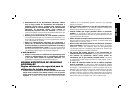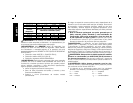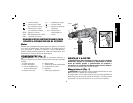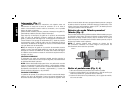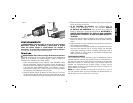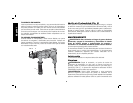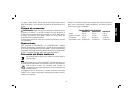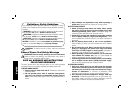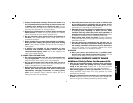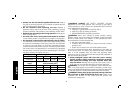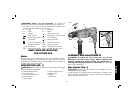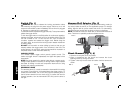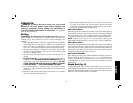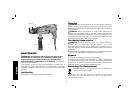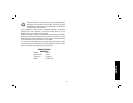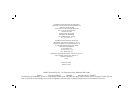
15
English
OPERATION
WARNING: To reduce the risk of injury, turn unit off and
disconnect tool from power source before installing and
removing accessories, before making any adjustments or
removing/installing attachments or accessories. An accidental
start-up can cause injury.
Drilling
WARNING: To reduce the risk of personal injury, ALWAYS
ensure workpiece is anchored or clamped firmly. If drilling thin
material, use a wood “back-up” block to prevent damage to the
material.
1. Use sharp drill bits only. For WOOD, use twist drill bits, spade bits,
power auger bits, or hole saws. For METAL, use steel twist drill
bits or hole saws. For MASONRY, such as brick, cement, cinder
block, etc., use carbide-tipped bits rated for percussion drilling.
2. Always apply pressure in a straight line with the bit. Use enough
pressure to keep drill biting, but do not push hard enough to stall
the motor or deflect the bit.
3. Hold tool firmly with both hands to control the twisting action of
the drill.
4. IF DRILL STALLS, it is usually because it is being overloaded or
improperly used. RELEASE TRIGGER IMMEDIATELY, remove
drill bit from work, and determine cause of stalling. DO NOT
CLICK TRIGGER ON AND OFF IN AN ATTEMPT TO START
A STALLED DRILL — THIS CAN DAMAGE THE DRILL.
5. To minimize stalling or breaking through the material, reduce
pressure on drill and ease the bit through the last fractional part
of the hole.
6. Keep the motor running when pulling the bit back out of a drilled
hole. This will help prevent jamming.
7. With variable speed drills there is no need to center punch
the point to be drilled. Use a slow speed to start the hole and
accelerate by squeezing the trigger harder when the hole is deep
enough to drill without the bit skipping out.
DRILLING IN METAL
Start drilling with slow speed and increase to full power while applying
firm pressure on the tool. A smooth even flow of metal chips indicates
the proper drilling rate. Use a cutting lubricant when drilling metals.
The exceptions are cast iron and brass which should be drilled dry.
NOTE: Large [5/16" (8 mm) to 1/2" (13 mm)] holes in steel can be
made easier if a pilot hole [5/32" (4 mm) to 3/16" (5 mm)] is drilled first.
DRILLING IN WOOD
Start drilling with slow speed and increase to full power while applying
firm pressure on the tool. Holes in wood can be made with the same
twist drills used for metal. These bits may overheat unless pulled out
frequently to clear chips from the flutes. Work that is apt to splinter
should be backed up with a block of wood.
DRILLING IN MASONRY
When drilling in masonry, use carbide tipped bits rated for percussion
drilling and be certain that the bit is
sharp. Ensure that the hammer
mode is selected. Use a constant and firm force on the tool to drill
most effectively. A smooth, even flow of dust indicates the proper
drilling rate.
Depth Rod (fi g. 5)
To adjust the depth rod (F), loosen the handle (E) and move rod so
that the distance between the end of the rod and the end of the bit
equals the desired drilling depth. When drilling with depth rod, stop
when end of rod reaches surface of material.



